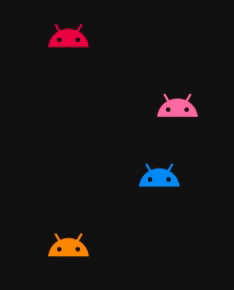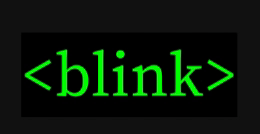Another small experiment to explore Jetpack Compose animations. I came to the conclusion that any value that is passed as a parameter could be animated, including anything in the modifier. So I set out to build a <blink> tag.
My first attempt creates a composable function that takes the modifier, animates it and passes it back to the content lambda. Like this:
@Composable
fun BlinkTag(
modifier: Modifier = Modifier,
durationMillis: Int = 500,
content: @Composable (modifier: Modifier) -> Unit
) {
val infiniteTransition = rememberInfiniteTransition()
val alpha: Float by infiniteTransition.animateFloat(
initialValue = 1f,
targetValue = 0f,
animationSpec = infiniteRepeatable(
animation = tween(durationMillis = durationMillis),
repeatMode = RepeatMode.Reverse
)
)
content(modifier = modifier.alpha(alpha))
}
When you use it you get a modifier back which you then pass to your content.
BlinkTag
Row {
Icon(
modifier = it, // <- like so
tint = RainbowRed,
painter = painterResource(id = R.drawable.ic_android_black_24dp),
contentDescription = null // decorative element
)
Text(
text = "blinky",
color = RainbowRed,
modifier = it.padding(8.dp) // <- and here too
)
}
}

The animation for this was a linear tween() between invisible and visible. However anyone who knows the blink tag will realise that it stays on longer than off. It blips off and then comes back on again staying visible for longer.
To do this I replaced the tween() with keyframes:
@Composable
fun BlinkTag(
modifier: Modifier = Modifier,
duration: Int = 500,
content: @Composable (modifier: Modifier) -> Unit
) {
val infiniteTransition = rememberInfiniteTransition()
val alpha: Float by infiniteTransition.animateFloat(
initialValue = 1f,
targetValue = 0f,
animationSpec = infiniteRepeatable(
animation = keyframes {
durationMillis = duration
1f at (duration*0.8).toInt() // we started at 1 and stay here for 80% of the time
0f at duration // then drop down to 0 in the last 20% of the time
},
repeatMode = RepeatMode.Reverse
)
)
content(modifier = modifier.alpha(alpha))
}

Reading the material theme docs I found out there was another way to share alpha values to a children in the composable tree using a LocalContentAlpha. This mechanims is used for emphasis using alpha and I am pretty sure the intention isn’t for this to be used to make layouts blink. I am doing this for science.
@Composable
fun LocalContentBlinkTag(
durationMillis: Int = 500,
content: @Composable () -> Unit
) {
val infiniteTransition = rememberInfiniteTransition()
val alpha: Float by infiniteTransition.animateFloat(
initialValue = 1f,
targetValue = 0f,
animationSpec = infiniteRepeatable(
animation = tween(durationMillis = durationMillis),
repeatMode = RepeatMode.Reverse
)
)
CompositionLocalProvider(LocalContentAlpha provides alpha) {
content()
}
}
When using this blink tag you no longer need to pass down the modifier since the changing alpha value is available to the children in a CompositionLocal
Use it like this:
LocalContentBlinkTag {
Row {
Icon(
painter = painterResource(id = R.drawable.ic_android_black_24dp),
contentDescription = null // decorative element
)
Text(text = "<blink>")
}
}

Although I defintely don’t support the irresponsible use of the blink tag, no investigation of reproducing retro website animations would be complete without a <blink> I realised again how powerful yet simple the animation system in Jetpack Compose can be. Be warned.
Find all the source in this repo
Also in this series:
